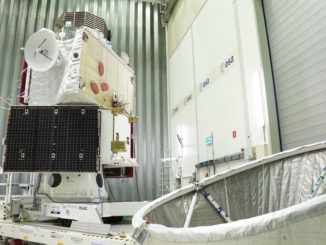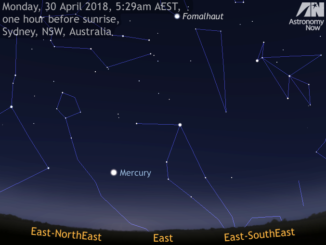
Shortly after 12:35pm GMT on Monday, 11 November 2019, suitably equipped observers in the British Isles can witness the start of a 3.7-hour spectacle that hasn’t been seen for three-and-a-half years — the silhouette of innermost planet Mercury transiting the face of the Sun.
Mercury makes one orbit of the Sun in just 88 days, but as seen from our moving vantage point on Earth the planet comes between us and the Sun (termed inferior conjunction) every 116 days, on average. Most times Mercury passes above or below the Sun’s disc, but 13 or 14 times every century, in the months of May or November when the orbital planes of Earth and Mercury align, the innermost planet can be seen passing directly in front of our nearest star.
Although Mercury is at its closest to Earth at inferior conjunction, it still lies some 101 million kilometres (63 million miles) distant at the middle of this transit. Given Mercury’s diameter of 4879 kilometres (3032 miles), this means that the planet will appear as a jet black circular silhouette just 9.9 arcseconds across, or 1/196th of the Sun’s diameter. This means that, as seen through special eclipse sunglasses, Mercury will be too small to see with the protected naked eye.
A caveat for binocular and telescope users
To see Mercury in transit, one must use a binocular or a telescope. I make no apologies for repeating the warning to never look at the Sun through an unfiltered optical instrument, even when it is low in the sky or heavily obscured by mist or fog. At such times the Sun may seem to be of a safe intensity, but the telescope will still concentrate harmful infrared and ultraviolet light that will damage your eyesight. Furthermore, clouds can break in an instant and glimpsing the Sun — even for a fraction of a second — can cause instant and irreparable eye damage.
The British Astronomical Association (BAA) has an excellent online guide to viewing the Sun safely.
In short, you must use either a commercially available solar filter securely covering the aperture of your telescope, a Hydrogen-alpha or Calcium-K instrument such as a Coronado Personal Solar Telescope, or — most simply, safely and cheaply — project an image of the Sun from one side of a tripod-mounted binocular or small refractor onto a card placed a convenient distance behind the eyepiece. Remember to keep the telescope’s finder capped and cover the other lens of the binocular!

Point the telescope or binocular at the Sun by noting when its shadow appears smallest on the projecting card. You can then improve contrast in the projected image by positioning a cardboard sunshade close to the front of the telescope or binocular. A good size for a projected solar image is 100—150mm (4—5 inches), which will show Mercury as a millimetre-sized dot. Sunspots may also be visible, but Mercury will appear darker and have a more sharply defined edge than these.
If you are unsure as to the orientation of your projected solar image, remember that the rotation of the Earth carries the Sun from celestial east to west; you will periodically have to nudge your tripod-mounted binoculars to keep the Sun centred on the card. An equatorially-mounted telescope with a motor drive or slow motion controls will make this much easier.
A transit timeline
Observers in different locations on Earth will see the transit taking place at a slightly different time due to parallax, as Mercury will appear to take a slightly different path across the Sun. All subsequent times in this article are expressed in Greenwich Mean Time (GMT)/Universal Time (UT) for an observer at the centre of the British Isles before sunset, but they will differ by no more than a few seconds wherever you may be in the UK.
-

AN graphic by Ade Ashford. 12h35m36s — First Contact
This is when we see the first ‘bite’ out of the limb (edge) of the Sun in white light as Mercury glides into view. Observers viewing in H-alpha light are likely to see Mercury before first contact in silhouette against the solar spicule layer, so be prepared a few minutes early. - 12h37m17s — Second Contact
Some 1.7 minutes after Mercury’s first appearance, the planet is now seen in full silhouette against the solar photosphere. - 15h19m50s — Greatest Transit

AN graphic by Ade Ashford. As seen from the heart of the British Isles, Mercury is halfway through its transit of the Sun. The planet is now just 6 degrees high in the southwest as seen from the centre of the UK, so seeing conditions will deteriorate as sunset approaches.
- 16h18m — sunset as seen from the centre of the British Isles.
-

AN graphic by Ade Ashford. 18h02m25s — Third Contact
As seen from the Americas, Mercury is tangential to the solar limb, poised to leave the Sun’s disc.As stated previously, where you observe from on Earth alters the timing of the event due to parallax. As seen from New York, for example, Third Contact occurs at 18:02:39 UT, or 18:02:08 UT as viewed from Buenos Aries. - 18h04m06s — Fourth Contact
Mercury finally glides off the face of the Sun, concluding this transit.
The global view
One hopes to see at least a fleeting glimpse of Mercury through a correctly filtered telescope between scudding clouds in the 3.7 hours from the start of the transit until sunset in the UK. The full 5.2-hour transit is observable from eastern North America and in its entirety from Central and South America. The Sun sets in Europe and Africa before the end of the transit, but Indondesia, Japan and Australia miss the event entirely. However, New Zealand can see the end of Mercury’s transit shortly after sunrise.
Future transits of Mercury
Should you be completely clouded out on 11 November 2019 (see also below), you have to wait until 13 November 2032 for the next transit of Mercury. However, the next transit of the innermost planet wholly visible from parts of the British Isles occurs on 7 November 2039!
View the transit online
If you don’t have an optical instrument, have left it too late to buy your solar filter, or the weather doesn’t oblige, why not watch the spectacle unfold online? The Virtual Telescope Project starts live streaming at 12:30 GMT/UT (7:30am EST) on 11 November.



